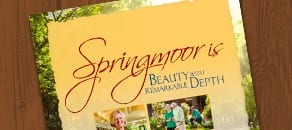By Thom Morgan, Springmoor Lanscape Manager
Most of us are very fortunate to have all of our five senses and move freely with out the aid of medical devices or help from others. A park, arboretum or any other public space, however, should and—with current laws—must be made accessible to folks with Special Needs.
The most well known special need to keep in mind is Handicap Access. For example, parking stalls, ramps and walkways are all required to be a certain width, height and slope percentage. Walkways should be at least five feet wide and slope no more than 1 foot high in a distance of 12 feet—often given as a ratio of 1:12. Walkways ending at street intersections should have curb cuts, and some walks have dimpled textured concrete where the sidewalk connects to a street. This prevents wheel chairs from sliding into a street and warns blind people when they are approaching a street.
Touch: Raised planting beds of a height of around 30 inches allows for handicappers, especially the blind, to feel plants with textural qualities. Plants with interesting textural surfaces include Lambs Ear, Dusty Miller, Angels Hair Artemisia, Jerusalem Sage, Mexican Bush Sage, Licorice Plant, Fountain Grasses, Irish Moss and Chenille plant. They grow indoors, can be containerized, and have great looking pink, caterpillar-like fuzzy flowers. Pussy willow is a small tree that has a fuzzy texture, but because of its height, it would be unreachable to most handicap people unless cuttings were taken down for them.
Scent: Scent is a wonderful way for blind people to enjoy a garden. A garden designed for these folks would definitely have to have many of the Gardenia varieties. Here at Springmoor, I plant them every chance I get near a walkway or an entrance. Other plants known for their fragrant qualities include Winter Daphne, Spicebush, Korean Lilac, Mr. Lincoln Rose, Oriental Lilies, Chaste Tree, Pink Dawn Viburnum, Sweet Shrub, Summersweet Clethra, Flowering Anise, and Anise.
Sound: Water can be manipulated in a wide variety of ways – everything from the drip of a mountain spring, to a thundering waterfall, can be achieved with all of the new pumps available. Plants that provide food for birds ensure that birds stay within hearing range of their calls. There are too many plants to list here, but any plant with edible berries is sure to bring them in. Some varieties of plants provide their own sound with the aid of the wind. For example, Golden Rain Trees get little Chinese lanterns with a seedpod that rattles when ripe.
April Focal Points – What’s Blooming Now
Dogwood, (Cornus florida) Nothing says spring like this tree, and we have several here at Spingmoor. Most of them are white, but there is a pink variety at the Memorial Garden, and one at house number 44.
Red Bud, (Cercis canadensis) Red buds are another springtime favorite. They are a suitable companion to dogwoods because both like the edges of woods and partial sun. We have several on campus (mostly the pink variety) with a white variety at the Administration Building.
Crabapple, (Malus sp.) Think of it as a dwarf apple tree! The fruit on some varieties are edible, but very tart. You can find a few at Springmoor: the front of house two, alongside house one, the circle at West Apartments and behind house fourteen.
Kwanzan Cherry, (Prunus serrulata) I sprinkled a few around campus and got quite a few calls when they bloomed. There are thousands of pink rose-like blossoms that completely cover the tree. Find the kwanzans at Entrance 5 West, behind Supportive Living and at the recycling entrance East Apartments.
Azaleas, (Azalea sp.) You can find them all over both campuses and we have early, mid season and late season varieties. We also have the Encore azaleas that bloom in the spring, and fall.
April Things to Do
- If you fertilized your roses on Valentines Day, the next feeding will be the last week of March, or the first week of April. Use any good quality rose food that also has insecticide in it.
- April 15 is the average last frost-free date of the previous year. It’s a good time to start the spring and summer vegetables. If you have room, stagger plantings two weeks apart so you don’t get over run with vegetables. If you do, give the surplus to a neighbor or to a food bank.
- Fertilize trees and shrubs you planted last year with 10 10 10 or 8 8 8 fertilizer.
- April is the last month to plant large, ball and burlapped trees. It soon gets too warm to transplant large trees and you are better off waiting until the first frost in fall.






